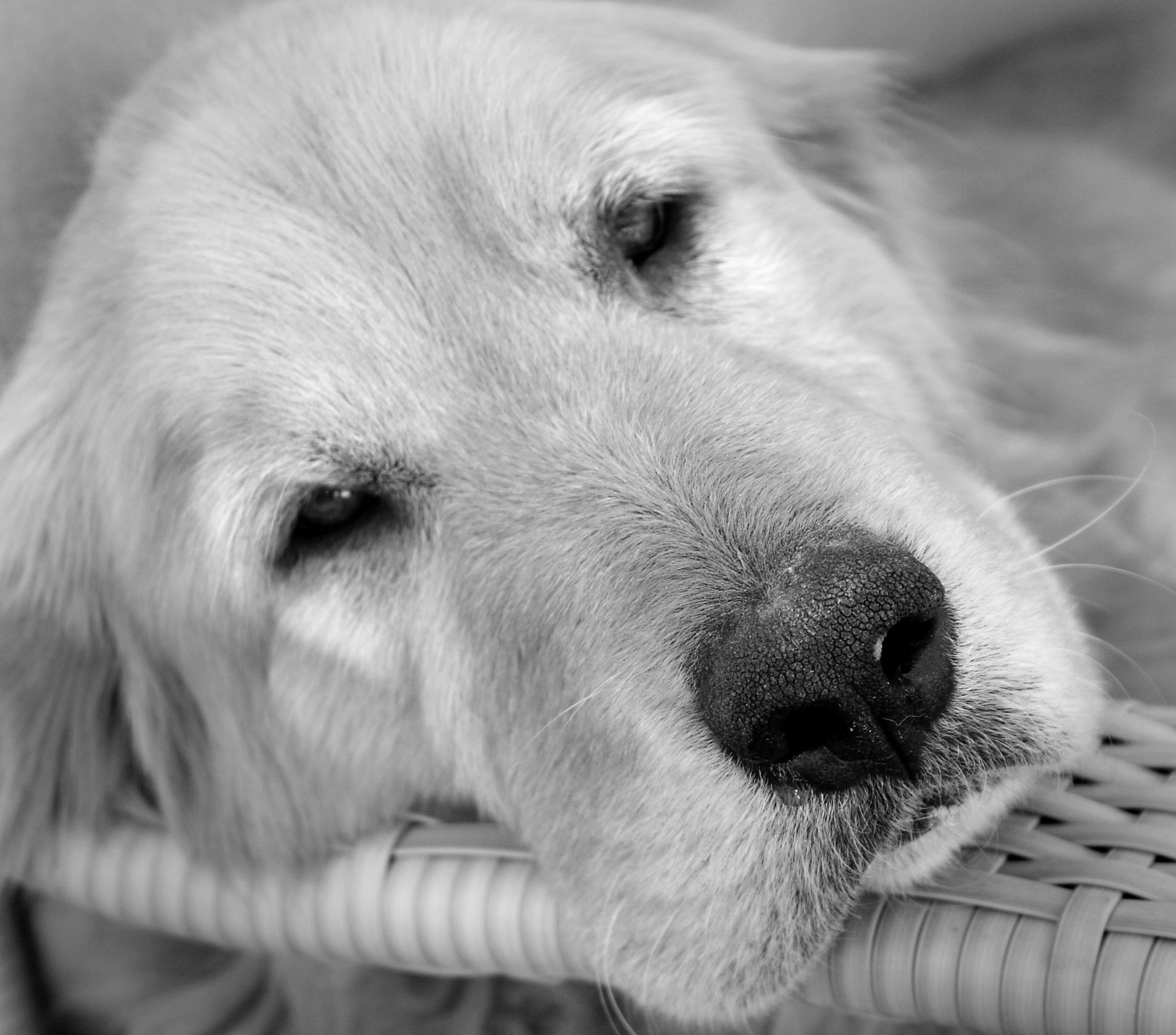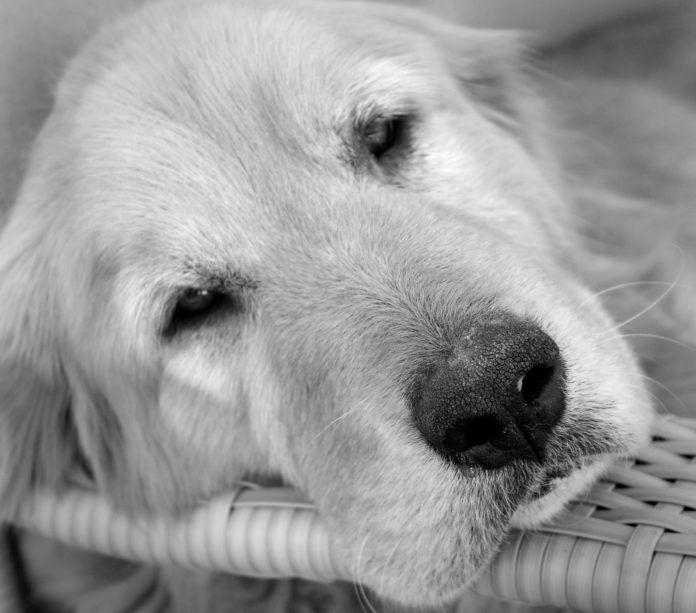All too often the veterinarians who work at our hospital for small animals walk by the bench just outside the building’s entrance and find people crying. Sometimes it’s a person sitting alone, sometimes a couple, sometimes a family with children. But no matter how familiar we are with the sadness, it never becomes less touching, whether or not we know the particular animal being grieved over. Indeed, most, if not all of us, know such grief firsthand.
Of course, it would be best for a dog to die peacefully in her sleep, or at least suddenly from a heart attack or stroke that takes life away in a single moment rather than forces the animal to linger in pain. That is, the best death for a beloved pet is the same as it would be for a person you love. But it rarely goes that way. In fact, chances are high that you’re going to outlive your pet and further, that at some point down the road you’re going to be faced with the difficult decision of when to put her down to take her out of her suffering. Euthanasia is more often than not part of the life cycle with an animal who has become a family member.
When we talk about euthanasia to our clients, we do it in a room that’s sort of like a grief counseling room — a quiet spot that has large chairs. We take a good deal of time to explain all that’s involved, trying to gently guide owners through the steps of what, despite being a very sad process, is also a very peaceful one — much more peaceful, in fact, than many natural deaths.
Why bring up this unhappy subject? Because we feel it’s better to understand in advance how euthanasia works rather than be hit by surprise when your heart is in your throat. That will allow you to be pragmatic and act in your dog’s best interest even when your emotions will be running high.
Istock


How will you know it’s time?
What looms largest on most people’s minds when it comes to euthanasia, particularly when an older dog is diagnosed with a serious disease for which there is no cure but only palliative care to keep her comfortable, is the question of how they can be sure it’s time to make the decision.
Oftentimes, you won’t know the answer, at least, not right up front. Yes, you know your dog better than anyone, and at a certain point it’ll be clear to you that she deems her life no longer worth living. But before that point, it’s critical that you partner with your veterinarian. Consider that many conditions of older dogs that look like “the end” are eminently treatable. That’s why you should never make a decision to put down your dog without first taking her to the doctor for a definitive diagnosis. You might very well be surprised — and enormously relieved — to learn that her time has not yet come but that perhaps she just needs a certain medication or other therapeutic treatment. We’ve delivered that good news to many an owner who mistakenly thought their time with their pet was over.
On the other hand, when a definitive diagnosis of an ultimately terminable disease has been made, or even if the illness hasn’t been identified with certainty but it’s clear that it’s terminal — and painful — a doctor can go over with you how to keep your pet comfortable and content for as long as possible and also how to recognize the point at which, for all intents and purposes, her life is over. Dogs often do not vocalize their pain by crying out or moaning or changing their facial expressions, as people do. But a dog may demonstrate that she has reached the end of the line by, for instance, no longer exhibiting any interest whatsoever in playing; refusing to eat; or ceasing to show any enthusiasm whatsoever for family members. Certainly, a dog who is so sick she won’t touch her food is in about as much physical distress as is possible. Thus, such changes in your dog’s quality of life will serve as your tip-off that she has, in essence, already “checked out.” At that point, it shouldn’t be too agonizing to decide whether to put her down.
There’s often plenty of agonizing about whether to treat an illness, and to what degree. But once a grim diagnosis has been made and the dog goes on to exhibit the telltale signs of extreme physical distress, the decision about whether to order euthanasia does not necessitate more weighing of circumstances.
Still, some people do struggle with the decision, and it’s perfectly normal, sometimes taking loving owners two to three weeks to come to terms with the inevitable after their dog has shown that she does not want to engage any further in life. But come to terms they do, putting what’s best for their pet ahead of what they want for themselves. The more difficult aspect of euthanasia is not about whether it’s the right way to go but, rather, the guilt engendered by ending the life of a loved one. Because it’s legal to euthanize an animal but not a person, it can raise a lot of inner conflict.
We believe having the option to put down a pet is a good one and allows for humane treatment right through to the end. Not that it isn’t hard for us to do. It is. Putting down an animal “never gets easier, especially if it’s an animal you’ve been working with for a long time,” says John Berg, DVM, editor in chief of Your Dog. But if a dog is so done with living, so miserable, that she won’t even greet you when you come through the door, let alone lift her head, putting her down rather than forcing her to wait to die naturally spares her the agony of death. The euthanasia becomes a tool to end her suffering.
Deciding on the moment
Often, once your veterinarian tells you that she or he would support your decision to opt for euthanasia, you can set up an appointment to have it done rather than go through with it right at that particular office visit.
Choose a time that you’ll be able to go home right afterwards and cry with abandon, reflect meditatively, collapse, or do whatever it is you feel you need to do. Since you’re no doubt going to feel drained, there’s no point in picking a Monday morning when you’ll have to rush off to work rather than, say, a Friday afternoon, after which you can choose to be by yourself, or in the company of loved ones.
The procedure itself
When you bring in your dog for the appointment, we strongly advise you to pay for the euthanasia beforehand; depending on where you live, it will cost anywhere from $50 to $250. We say this because afterward, you’re just going to want to get in your car and leave. The last thing you’re going to want to do is engage in small talk with strangers at the front desk, along with filling out paperwork and trying to have a “stiff upper lip” in order not to burden others in the waiting room.
During the actual procedure, remain in the room with your dog if you can. “I think it helps people to be there,” Dr. Berg says. “They get a good feeling from the fact that they were with their pet, that they didn’t leave her by herself at the end. They get a feeling of closure, too. The dog looks at peace, and now they’ve seen the animal through her entire life and death; they’ve been there for the whole cycle.”
The euthanasia is performed by the veterinarian with an injection that contains a combination of pentobarbital and phenytoin. Pentobarbital is a barbiturate that used to be given to start anesthesia. In this case, it is given in an overdose. The phenytoin adds to the depression of the nervous system and stops the heart.
It’s all completely painless. The barbiturate literally causes the dog to fall asleep. And because phenytoin severely depresses the respiratory system at the brain level, it causes respiratory and cardiac arrest without the dog ever being aware.
Some vets give a tranquilizer first to calm the dog for the procedure, but by that point in the dog’s life, it’s usually not necessary. Tranquilizer or not, the vet puts a small intravenous catheter into a vein in one of the dog’s front limbs, then injects the two drugs — as a liquid — through the catheter. Within 15 seconds the dog is asleep and within a minute, she is gone.
Some dogs take what are known as agonal breaths as the body systems shut down. These are deep, almost sighing, breaths, and it could look as if the dog is trying to live. She is not. Agonal breaths are simply an unconsciously generated respiratory pattern often associated with death. They are not driven by any perception of the experience on the dog’s part.
Be aware that some dogs may also lose bladder control at the very end, which some people find distressing. Also, the dog may look dead rather than asleep, with her eyes open. If you’re aware of these possibilities beforehand, they will be less distressing should they occur.
After the procedure, the doctor checks for a heartbeat with a stethoscope, feels for the absence of a pulse on one of the back legs, and taps the dog’s eyes to make sure there’s no blink response.
When it’s all over
It is perfectly normal to feel inconsolable when it’s all over. After all, you bring home a dog to begin with because you want to form a close bond with one. Why wouldn’t the breaking of that bond hurt terribly?
People grieve differently. Some want to be alone while others want to be in the company of loved ones. The way to go about it is the way that feels right to you. If you feel the need to go beyond your own support network, Tufts has a grief counseling service available to anyone, anywhere in the country. Called the Pet Loss Hotline, it is run by veterinary students who receive training from a licensed psychologist. Callers may speak as long as they wish. To learn more, visit www.tufts.edu/vet/petloss or call (508) 839-7966. The website explains how to talk to children about the loss of a pet and also lists a number of other resources.
A next dog?
Some people consider whether to get a new dog when they learn the dog they have is dying. They feel it might be better to avoid a gap between pets. We recommend against it. The dog you have and love right now needs your undivided attention more than ever. And nothing will draw away attention like a new dog, especially if it’s a puppy, who requires a lot of care in order to bond with you correctly. Then, too, your dog may not like the new dog (would you want to have a new family member come live with you while dying?), so you risk subjecting her to unhappy social interactions in her last days.
As for taking in a dog after you lose one, most people don’t want to until they are done grieving, and their instincts serve them well. It doesn’t feel good for most people to bring a new dog into their lives while the loss of the one they have loved for quite some time still stings. It isn’t fair to the new dog, either. Her homecoming should be a happy time, with her getting lots of spirited attention.
Thus, don’t rush into getting a new dog because you think you should, or because you feel it will help you get over the loss more quickly. Wait until it feels right. For some people that’s weeks. For others, it’s months, or longer.
Keep in mind that no dog will ever “replace” the one you lost. A new one may have wonderful qualities, some of which overlap with the dog now gone, but the package, the gestalt, is going to be different from one dog to another. That’s okay. Each of us has within us the capacity to expand our love in new directions.





